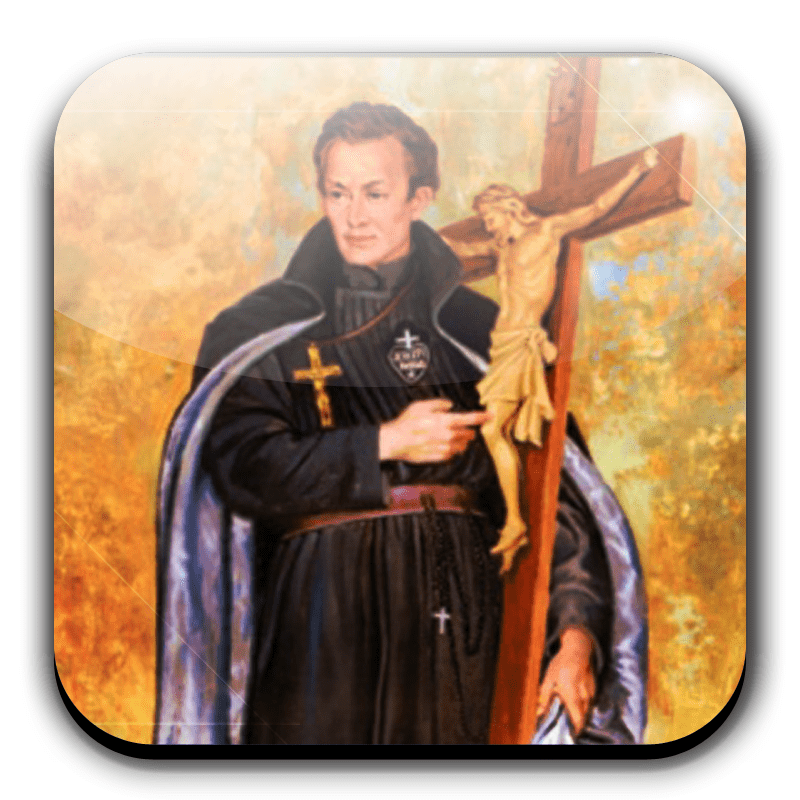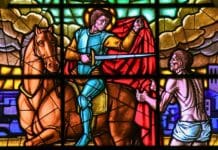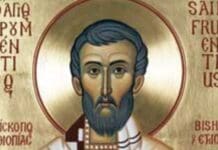Saint Paul of the Cross originally named Paolo Francesco Danei, was born on 3 January 1694, in the town of Ovada, Piedmont, between Turin and Genoa in the Duchy of Savoy in northern Italy. He is considered to be among the greatest Catholic mystics of the eighteenth century.
Paul, a son of a wealthy merchant family experienced a conversion to a life of prayer at the age of 19, after a very normal and pious life. His early reading of the “Treatise on the Love of God” by Saint Francis de Sales and the direction he received from priests of the Capuchin Order taught him the primacy of love and at the same time the need to go beyond our own images of God. It became St Paul’s lifelong conviction that God is most easily found by us in the Passion of Jesus Christ. He saw the Passion of Christ as being the most overwhelming sign of God’s love and at the same time the door to union with him. His life was devoted to bringing this message to all and founding a community whose members would do the same.
When he was 26 years old, St Paul of the Cross had a series of prayer-experiences which made it clear to him that God was inviting him to form a community who would live an evangelical life and promote the love of God revealed in the Passion of Jesus. In a vision, he saw himself clothed in the habit he and his companions would wear: a long, black tunic on the front of which was a heart surmounted by a white cross, and in the heart was written “the Passion of Jesus Christ”. On seeing it, he heard these words spoken to him: “This is to show how pure the heart must be that bears the holy name of Jesus graven upon it”. The first name Paul received for his community was “the Poor of Jesus”; later they came to be known as the Congregation of the Passion of Jesus Christ, or the Passionists.
With the encouragement of his bishop, who clothed him in the black habit of a hermit, Paul wrote the rule of his new community (of which he was, as yet, the only member) during a retreat of forty days at the end of 1720. The community was to live a penitential life, in solitude and poverty, teaching people in the easiest possible way how to meditate on the Passion of Jesus.
His first companion was his own brother, John Baptist, who was ordained to the priesthood with Paul by Pope Benedict XIII on 7 June 1727, in St. Peter’s Basilica, Rome. After ordination they devoted themselves to preaching missions in parishes, particularly in remote country places where there were not a sufficient number of priests pastorally involved. Their preaching apostolate and the retreats they gave in seminaries and religious houses brought their mission to the attention of others and gradually the community began to grow.
The austerity of life practiced by the first Passionists did not encourage large numbers, but Paul preferred a slow, at times painful, growth to something more spectacular. His main aim in the community was, as he said himself, to form “a man totally God-centred, totally apostolic, a man of prayer, detached from the world, from things, from himself so that he may in all truth be called a disciple of Jesus Christ.” The first Retreat (the name Passionists traditionally gave to their monasteries) was opened in 1737 on Monte Argentario (Province of Grosseto); the community now had nine members. Paul called his monasteries “retreats” to underline the life of solitude and contemplation which he believed was necessary for someone who wished to preach the message of the Cross. In addition to the communal celebration of the divine office, members of his community were to devote at least three hours to contemplative prayer each day.
During his lifetime, Paul of the Cross was best known as a popular preacher and a spiritual director. More than two thousand of his letters, most of them letters of spiritual direction, have been preserved.
He died on 18 October 1775, at the Retreat of Saints John and Paul (SS. Giovanni e Paolo). By the time of his death, the congregation founded by Saint Paul of the Cross had one hundred and eighty fathers and brothers, living in twelve Retreats, mostly in the Papal States. There was also a monastery of contemplative sisters in Corneto (today known as Tarquinia), founded by Paul a few years before his death to promote the memory of the Passion of Jesus by their life of prayer and penance.
Saint Paul of the Cross was beatified on 1 October 1852, and canonized on 29 June 1867 by Blessed Pius IX. Two years later his feast day was inserted in the Roman calendar, for celebration on 28 April as a Double. In 1962 it was reclassified as a Third-Class feast, and in 1969 it became an optional Memorial and was placed on 20 October, the free date two days closer to the day of his death, 18 October, which is the feast of Saint Luke the Evangelist.


















What’s up,I log on to your blog named “St. Paul of the Cross | uCatholic” daily.Your writing style is awesome, keep up the good work! And you can look our website about تحميل مهرجانات شعبى.
Ecce Crucem Domini!
Fugite partes adversae!
Vicit Leo de tribu Juda,
Radix David! Alleluia!
Saint Anthony, pray for us. For Italy.
Saint Teresa of Avila, pray for us. For Rome.
Saint Paul of the Cross, pray for us. For all Passionists cooperating with God’s grace through Christ Crucified. Grant perpetual Lent and an appreciation of year round sacrificial suffering through the Stations of the Cross. Amen.